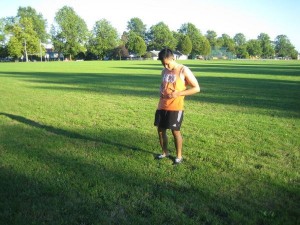Sacroiliac joint pain can occur either to the left or right of the lower back but some people describe it as a band of pain felt across the lower back. The pain ranges from an ache to severe pain which limits movement.
https://www.youtube.com/watch?v=9rnSaECejyo
Sacroiliac pain can spread into the buttocks and lower back and sometimes into the front of the groin and the testicles. Sitting for long periods of time and getting up from bed in the morning causes stiffness in the lower back.
Causes of sacroiliac joint pain

- Structural leg length caused by shortening of one or more bones in the lower extremities. Pain can be felt on the short side with pain on the knee facing away from the body and trochanteric bursitis.
- Dysfunction of the sacroiliac joints when moving the lower back, pelvic structure and tissues caused by bending, lifting, sitting and arching or twisting the spine with weight-bearing forces together with running and jumping.
- Inflammatory joint disease such as osteoarthritis and rheumatoid arthritis. Osteoarthritis is a degenerative disease of the joints that usually affects older people. Rheumatoid arthritis is a chronic inflammatory disorder that can also affect the sacroiliac joints and women are more susceptible to this condition than in men.
Treatment
- Take plenty of rest especially the affected area to lessen irritation.
- Apply an ice pack on the area for at least 15-20 minute intervals to lessen the inflammation and pain. Avoid placing the pack directly on the skin to prevent frostbite that can worsen the condition. Wrap the pack in a towel or piece of cloth before applying on the affected area. Continue applying the ice pack on the area.
- Apply a heat wrap or take a hot bath for fast healing of the area.
- Take the prescribed over-the-counter pain medications such as acetaminophen and anti-inflammatory medications such as ibuprofen or naproxen to lessen the swelling and pain.
- Wear support braces that are wrapped around the waist and pulled snugly for stability of the affected area.
- Seek the help of the physical therapist for strengthening exercises for the muscles around the sacroiliac joint and increased range of motion. Perform gentle low impact aerobic exercises for proper flow of blood in the area and for fast healing of the condition.
